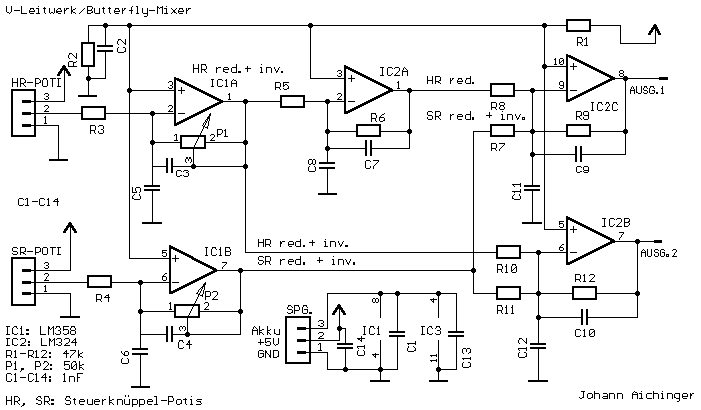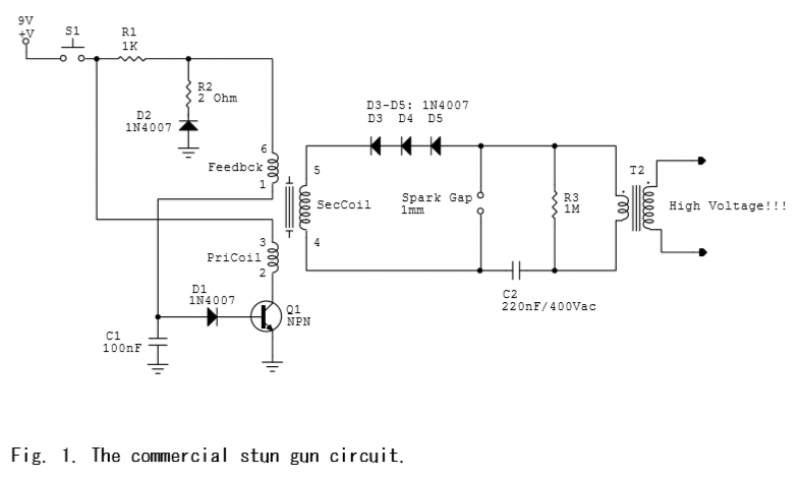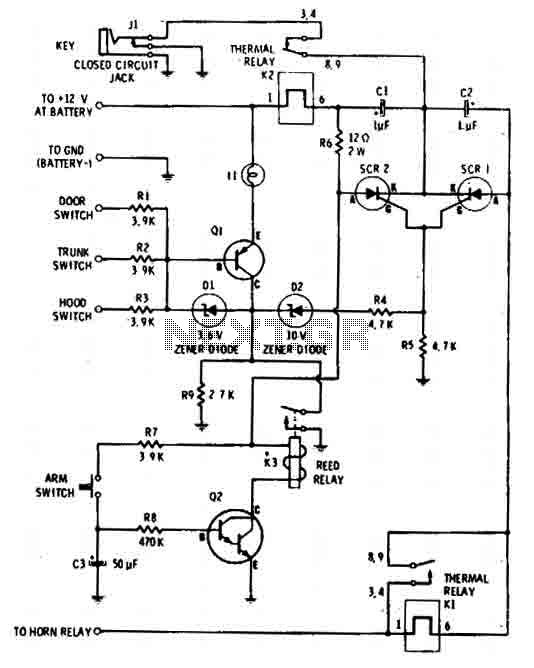
music circuit

This circuit allows for the adjustment of resistance using a potentiometer and the adjustment of capacitance by opening or closing switches. By manipulating the configuration of these switches, various combinations can be achieved to obtain different effective capacitance values. It is noted that unusual operations may lead to odd ringing sounds. The design incorporates the inductance of the wiring to produce additional noise effects.
This circuit is designed to provide flexibility in tuning both resistance and capacitance, which is essential in applications such as audio synthesis, signal processing, or RF circuits. The potentiometer serves as a variable resistor, allowing for fine-tuning of the resistance value. This adjustment can impact the time constant of the circuit, influencing how quickly it responds to changes in input signals.
The capacitance can be modified through a set of switches that connect or disconnect capacitors in parallel or series configurations. Each combination of open and closed switches alters the total capacitance seen by the circuit, enabling a wide range of capacitance values. This feature is particularly useful in applications where specific frequency responses are required, such as in filters or oscillators.
The circuit's tendency to produce ringing sounds is an important characteristic, as it indicates the presence of resonant frequencies. This can occur when the inductance of the wiring interacts with the capacitance values set by the switches, creating oscillations in the circuit. These oscillations can be harnessed creatively to generate unique sound effects, making the circuit valuable in experimental audio applications.
In summary, this adjustable resistance and capacitance circuit not only allows for precise control over its electrical characteristics but also introduces the potential for creative sound manipulation through resonance and inductive effects. Proper understanding and experimentation with the circuit can lead to innovative applications in electronic sound design and synthesis.That circuit allows you to adjust the resistance (with a pot) and adjust the capacitance by opening or closing switches. So, you can have any combination of switches open or closed to get a different effective capacitance.
as a side note, if he does crazy stuff and causes odd ringing sounds to come out of it. Or if after there are sounds there are after effects he designed this system to use the inductance of the wiring to cause ringing to get extra noises. Kortuk™ Jun 9 `10 at 4:17 Kortuk - that`s interesting, can you be a bit more clear It definitely sounds like that`s a possibility.
Is it some sort of resonance Greg Jun 9 `10 at 15:14 🔗 External reference
This circuit is designed to provide flexibility in tuning both resistance and capacitance, which is essential in applications such as audio synthesis, signal processing, or RF circuits. The potentiometer serves as a variable resistor, allowing for fine-tuning of the resistance value. This adjustment can impact the time constant of the circuit, influencing how quickly it responds to changes in input signals.
The capacitance can be modified through a set of switches that connect or disconnect capacitors in parallel or series configurations. Each combination of open and closed switches alters the total capacitance seen by the circuit, enabling a wide range of capacitance values. This feature is particularly useful in applications where specific frequency responses are required, such as in filters or oscillators.
The circuit's tendency to produce ringing sounds is an important characteristic, as it indicates the presence of resonant frequencies. This can occur when the inductance of the wiring interacts with the capacitance values set by the switches, creating oscillations in the circuit. These oscillations can be harnessed creatively to generate unique sound effects, making the circuit valuable in experimental audio applications.
In summary, this adjustable resistance and capacitance circuit not only allows for precise control over its electrical characteristics but also introduces the potential for creative sound manipulation through resonance and inductive effects. Proper understanding and experimentation with the circuit can lead to innovative applications in electronic sound design and synthesis.That circuit allows you to adjust the resistance (with a pot) and adjust the capacitance by opening or closing switches. So, you can have any combination of switches open or closed to get a different effective capacitance.
as a side note, if he does crazy stuff and causes odd ringing sounds to come out of it. Or if after there are sounds there are after effects he designed this system to use the inductance of the wiring to cause ringing to get extra noises. Kortuk™ Jun 9 `10 at 4:17 Kortuk - that`s interesting, can you be a bit more clear It definitely sounds like that`s a possibility.
Is it some sort of resonance Greg Jun 9 `10 at 15:14 🔗 External reference





